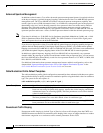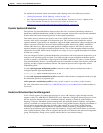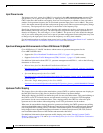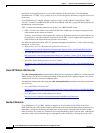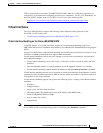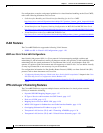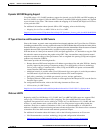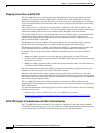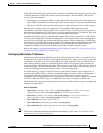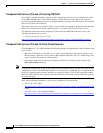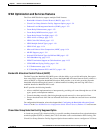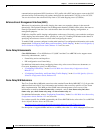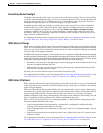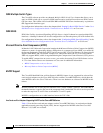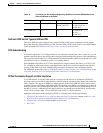
1-128
Cisco uBR7200 Series Universal Broadband Router Software Configuration Guide
OL-2239-05
Chapter1 Overview of Cisco uBR7200 Series Software
cops tcp window-size
Mapping Service Flows to MPLS-VPN
The Cisco uBR7200 series routers have been providing Managed Access using multiprotocol label
switching-virtual private networks (MPLS-VPNs) configured over cable subinterfaces, with each
subinterface configured for a specific ISP. Thus, service providers have a manageable way to offer users
access to multiple Internet Service Providers (ISPs) over the same physical hybrid fiber-coaxial (HFC)
cable network.
This system works very well when all customer premises equipment (CPE) devices behind a cable
modem are using the same ISP. However, users are increasingly requesting more complex networks that
would allow multiple CPE devices to access different ISPs through the same cable modem.
For example, different users in one household might want to use different PCs to access different ISPs.
Another increasingly common situation is that one user requires a secure VPN connection for
telecommuting through one ISP, while other users in the household use other computers to access the
public Internet through a separate ISP.
The Mapping Service Flows to MPLS-VPN feature enhances this existing MPLS-VPNs support to
provide more flexible Managed Access for different ISPs through the same cable modem.
The Mapping Service Flows to MPLS-VPN feature uses DOCSIS 1.1 upstream packet classifiers and
service flow IDs (SFIDs) to map individual CPE devices to separate MPLS-VPN interfaces.
In summary, the service provider creates a DOCSIS configuration file for each cable modem that
contains:
• Multiple secondary upstream service flows that specify QoS profiles for each CPE device.
• A Vendor Specific QoS Parameter that identifies the MPLS-VPN route to be used for packets using
a particular service flow.
• Multiple secondary upstream packet classifiers that specify the MAC address for each CPE device
as the Source MAC Address parameter.
The cable modem then downloads the DOCSIS configuration file during its registration process and
configures itself for the proper service flows and packet classifiers.
When the cable modem comes online, it begins receiving packets from its CPE devices. The cable
modem uses the packet's source MAC address to match the packet to the proper packet classifier, which
then identifies the correct SFID to use. The cable modem then transmits the packet to the Cisco uBR7200
series router using this upstream SFID.
The Cisco uBR7200 series router examines the packet to determine its SFID, and then uses the
Vendor-Specific QoS Parameter associated with that service flow to route the packet to the appropriate
MPLS-VPN interface.
For additional information on the Mapping Service Flows to MPLS-VPN feature, refer to the following
document on Cisco.com:
• Mapping Service Flows to MPLS-VPN on the Cisco uBR7200 Series Router
http://www.cisco.com/univercd/cc/td/doc/product/software/ios122/122newft/122limit/122bc/
122bc_11/sfidmpls.htm
MPLS VPN Support for Subinterfaces and Cable Interface Bundles
The Cisco uBR7200 routers offer MPLS VPN support for subinterfaces and cable interface bundles.
Using MPLS VPN technology, service providers can create scalable and efficient private networks using
a shared hybrid fiber coaxial (HFC) network and Internet protocol (IP) infrastructure.



